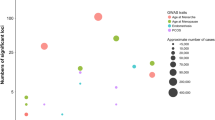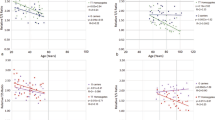Abstract
The present study investigated for a possible effect on fertility of four longevity candidate genes (ACE, PON1, PPAR-γ, APOE) in order to determine whether they have a pleiotropic action at different life ages. The study population was 151 healthy unrelated subjects. Only PPAR-γ and APOE showed an effect on fertility. The PPAR-γ Pro/Ala genotype, which had showed an association with longevity only in men, was found associated only in men with having produced more children (6.1 ± 3.3) than the Pro/Pro genotype (3.3 ± 1.9; P = 0.001). APOE*2 allele, which has been consistently associated with longevity, was confirmed to be associated with the lowest fertility (P = 0.03). The logistic regression analysis indicated that APOE and PPAR-γ polymorphisms may be considered independent determinants of reproductive efficiency. These data suggest that the APOE*2 allele follows the model of antagonist pleiotropy, while the PPAR-γ Pro/Ala genotype seems to exert beneficial effects both early in life and in advanced age in a gender-specific way.
Similar content being viewed by others
References
Altshuler D, Hirschhorn JN, Klannemark M, Lindgren CM, Vohl MC, Nemesh J et al (2000) The common PPARgamma Pro12Ala polymorphism is associated with decreased risk of type 2 diabetes. Nat Genet 26:76–80
Aquila S, Bonofiglio D, Gentile M, Middea E, Gabriele S, Belmonte M, Catalano S, Pellegrino M, Andò S (2006) Peroxisome proliferator-activated receptor (PPAR) gamma is expressed by human spermatozoa: its potential role on the sperm physiology. J Cell Physiol 209:977–986
Barbieri M, Bonafè M, Rizzo MR, Ragno E, Olivieri F, Marchegiani F, Franceschi C, Paolisso G (2004) Gender specific association of genetic variation in peroxisome proliferator-activated receptor (PPAR) gamma-2 with longevity. Exp Gerontol 3:1095–1100
Christensen K, Johnson TE, Vaupel JW (2006) The quest for genetic determinants of human longevity: challenges and insights. Nat Rev Genet 7:436–448
Christiansen L, Bathum L, Frederiksen H, Christensen K (2004) Paraoxonase 1 polymorphisms and survival. Eur J Hum Genet 12:843–847
Corbo RM, Scacchi R (2001) Distribuzione di alcuni fattori genetici di rischio per la malattia coronaria in un campione di ultraottuagenari del Cilento. Confronto con gli anziani di altre popolazioni europee. Risultati dello studio LONCILE. Riv Antrop 79(suppl): 49–58
Corbo RM, Scacchi R, Mureddu L, Mulas G, Alfano G (1995) Apolipoprotein E polymorphism in Italy investigated in native plasma by a simple polyacrylamide gel isoelectric focusing tecnique comparison with frequency data of other European populations. Ann Hum Genet 59:197–209
Corbo RM, Scacchi R, Cresta M (2004) Differential reproductive efficiency associated with common apolipoprotein e alleles in postreproductive-aged subjects. Fertil Steril 81:104–107
Corbo RM, Gambina G, Ulizzi L, Monini P, Broggio E, Rosano A, Scacchi R (2007) Combined effect of apolipoprotein e genotype and past fertility on age at onset of Alzheimer’s disease in women. Dement Geriatr Cogn Disord 24:82–85
Cresta M, Gregorio G (2001) Il disegno dello studio LONCILE. Riv Antrop 79:11–18
Deeb SS, Fajas L, Nemoto M, Pihlajamäki J, Mykkänen L, Kuusisto J, Laakso M, Fujimoto W, Auwerx J (1998) A Pro12Ala substitution in PPARgamma2 associated with decreased receptor activity, lower body mass index and improved insulin sensitivity. Nat Genet 20:284–287
Doblhammer G, Oeppen J (2003) Reproduction and longevity among the British peerage: the effect of frailty and health selection. Proc Biol Sci 270:1541–1547
Froment P, Gizard F, Defever D, Staels B, Dupont J, Monget P (2006) Peroxisome proliferator-activated receptors in reproductive tissues: from gametogenesis to parturition. J Endocrinol 189:199–209
Gerdes LU, Gerdes C, Hansen PS, Klausen IC, Faergeman O (1996) Are men carrying the apolipoprotein epsilon 4- or epsilon 2 allele less fertile than epsilon 3 epsilon 3 genotypes? Hum Genet 98:239–242
Gerdes LU, Jeune B, Ranberg KA, Nybo H, Vaupel JW (2000) Estimation of apolipoprotein E genotype-specific relative mortality risks from the distribution of genotypes in centenarians and middle-aged men: apolipoprotein E gene is a “frailty gene”, not a “longevity gene”. Genet Epidemiol 19:202–210
ISTAT (2008) http://demo.istat.it/unitav/index.html
Istituto Centrale di Statistica (1974) Indagine sulla fecondita` della donna. Note Relazioni 50:96–97
Korpelainen H (2000) Fitness, reproduction and longevity among European aristocratic and rural Finnish families in the 1700s and 1800s. Proc R Soc Lond B Biol Sci 267:1765–1770
Le Bourg E (2007) Does reproduction decrease longevity in human beings? Ageing Res Rev 6:141–149
Leroi AM, Bartke A, De Benedictis G, Franceschi C, Gartner A, Gonos ES, Fedei ME, Kivisild T, Lee S, Kartaf-Ozer N, Schumacher M, Sikora E, Slagboom E, Tatar M, Yashin AI, Vijg J, Zwaan B (2005) What evidence is there for the existence of individual genes with antagonistic pleiotropic effects? Mech Ageing Dev 126:421–429
Lio D, Candore G, Crivello A, Scola L, Colonna-Romano G, Cavallone L, Hoffmann E, Caruso M, Licastro F, Caldarera CM, Branzi A, Franceschi C, Caruso C (2004) Opposite effects of interleukin 10 common gene polymorphisms in cardiovascular diseases and in successful ageing: genetic background of male centenarians is protective against coronary heart disease. J Med Genet 41:790–794
Mackness B, Durrington PN, Mackness MI (1998) Human serum paraoxonase. Gen Pharmacol 31:329–336
Mahley RW, Rall SC (2000) Apolipoprotein E: far more than a lipid transport protein. Annu Rev Genomics Hum Genet 1:507–537
Meirhaeghe A, Amouyel P (2004) Impact of genetic variation of PPARgamma in humans. Mol Genet Metab 83:93–102
Miller SA, Dykes DD, Polesky HF (1988) A simple salting out procedure for extracting DNA from human nucleated cells. Nucleic Acids Res 16:1215
Mori H, Ikegami H, Kawaguchi Y, Seino S, Yokoi N, Takeda J, Inoue I, Seino Y, Yasuda K, Hanafusa T, Yamagata K, Awata T, Kadowaki T, Hara K, Yamada N, Gotoda T, Iwasaki N, Iwamoto Y, Sanke T, Nanjo K, Oka Y, Matsutani A, Maeda E, Kasuga M (2001) The Pro12/Ala substitution in PPARgamma is associated with resistance to development of diabetes in the general population: possible involvement in impairment of insulin secretion in individuals with type 2 diabetes. Diabetes 50:891–894
Panza F, Solfrizzi V, D’Introno A, Colacicco AM, Capurso C, Kehoe PG, Capurso A (2003) Angiotensin I converting enzyme (ACE) gene polymorphism in centenarians: different allele frequencies between the North and South of Europe. Exp Gerontol 38:1015–1020
Partridge L, Gems D, Withers DJ (2005) Sex and death: what is the connection? Cell 120:461–472
Rea IM, McKeown PP, McMaster D, Young IS, Patterson C, Savage MJ, Belton C, Marchegiani F, Olivieri F, Bonafe M, Franceschi C (2004) Paraoxonase polymorphisms PON1 192 and 55 and longevity in Italian centenarians and Irish nonagenarians. A pooled analysis. Exp Gerontol 39:629–635
Sayed-Tabatabaei FA, Oostra BA, Isaacs A, van Duijn CM, Witteman JC (2006) ACE polymorphisms. Circ Res 98:1123–1133
Scacchi R, Gambina G, Martini MC, Broggio E, Vilardo T, Corbo RM (2003) Different pattern of association of paraoxonase Gln192→Arg polymorphism with sporadic late-onset Alzheimer’s disease and coronary artery disease. Neurosci Lett 339:17–20
Scacchi R, Pinto A, Rickards O, Pacella A, De Stefano GF, Cannella C, Corbo RM (2007) An analysis of peroxisome proliferator-activated receptor gamma (PPAR-gamma 2) Pro12Ala polymorphism distribution and prevalence of type 2 diabetes mellitus (T2DM) in world populations in relation to dietary habits. Nutr Metab Cardiovasc Dis 17:632–641
Schachter F, Faure-Delanef L, Guenot F, Rouger H, Froguel P, Lesueur-Ginot L, Cohen D (1994) Genetic associations with human longevity at the APOE and ACE loci. Nat Genet 6:29–32
Seripa D, Franceschi M, Matera MG, Panza F, Kehoe PG, Gravina C, Orsitto G, Solfrizzi V, Di Minno G, Dallapiccola B, Pilotto A (2006) Sex differences in the association of apolipoprotein E and angiotensin-converting enzyme gene polymorphisms with healthy aging and longevity: a population-based study from Southern Italy. J Gerontol A Biol Sci Med Sci 61:918–923
Serrato M, Marian AJ (1995) A variant of human paraoxonase/arylesterase (HUMPONA) gene is a risk factor for coronary artery disease. J Clin Invest 96:3005–3008
Tiret L, Kee F, Poirier O, Nicaud V, Lecerf L, Evans A, Cambou JP, Arveiler D, Luc G, Amouyel P (1993) Deletion polymorphism in angiotensin-converting enzyme gene associated with parental history of myocardial infarction. Lancet 341:991–992
Ulizzi L, San Martini A, Terrenato L (1979) Changes of selection opportunities with a changing environment: regional heterogeneity in Italy. Ann Hum Genet 43:137–141
Westendorp RG, Kirkwood TB (1998) Human longevity at the cost of reproductive success. Nature 396:743–746
Westendorp RG, van Dunne FM, Kirkwood TB, Helmerhorst FM, Huizinga TW (2001) Optimizing human fertility and survival. Nat Med 7:873
Zubenko GS, Stiffler JS, Hughes HB III, Fatigati MJ, Zubenko WN (2002) Genome survey for loci that influence successful aging: sample characterization, method validation, and initial results for the Y chromosome. Am J Geriatr Psychiatry 10:619–630
Acknowledgements
We are grateful to K.A. Britsch for reviewing the manuscript. Financial support from University ‘La Sapienza’.
Author information
Authors and Affiliations
Corresponding author
Rights and permissions
About this article
Cite this article
Corbo, R.M., Ulizzi, L., Piombo, L. et al. Study on a possible effect of four longevity candidate genes (ACE, PON1, PPAR-γ, and APOE) on human fertility. Biogerontology 9, 317–323 (2008). https://doi.org/10.1007/s10522-008-9143-9
Received:
Accepted:
Published:
Issue Date:
DOI: https://doi.org/10.1007/s10522-008-9143-9




